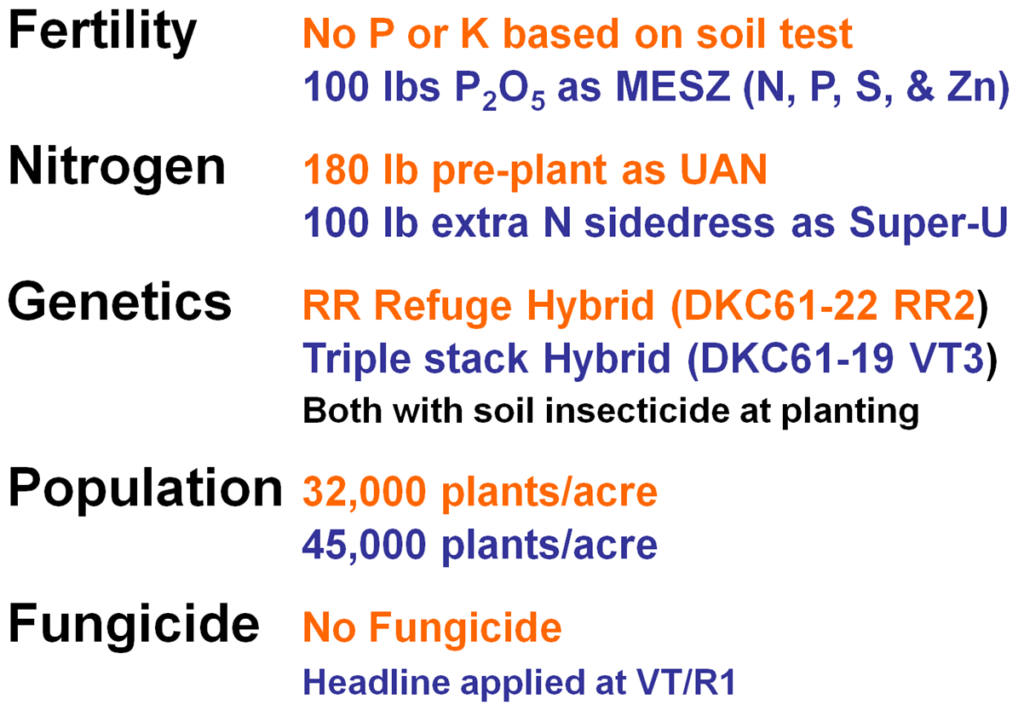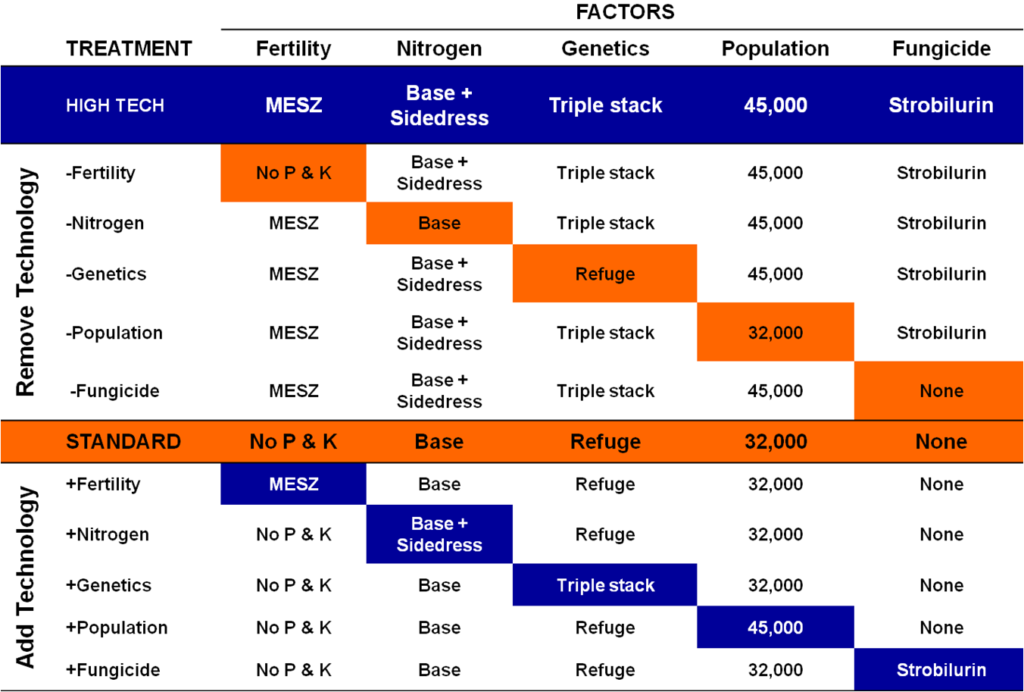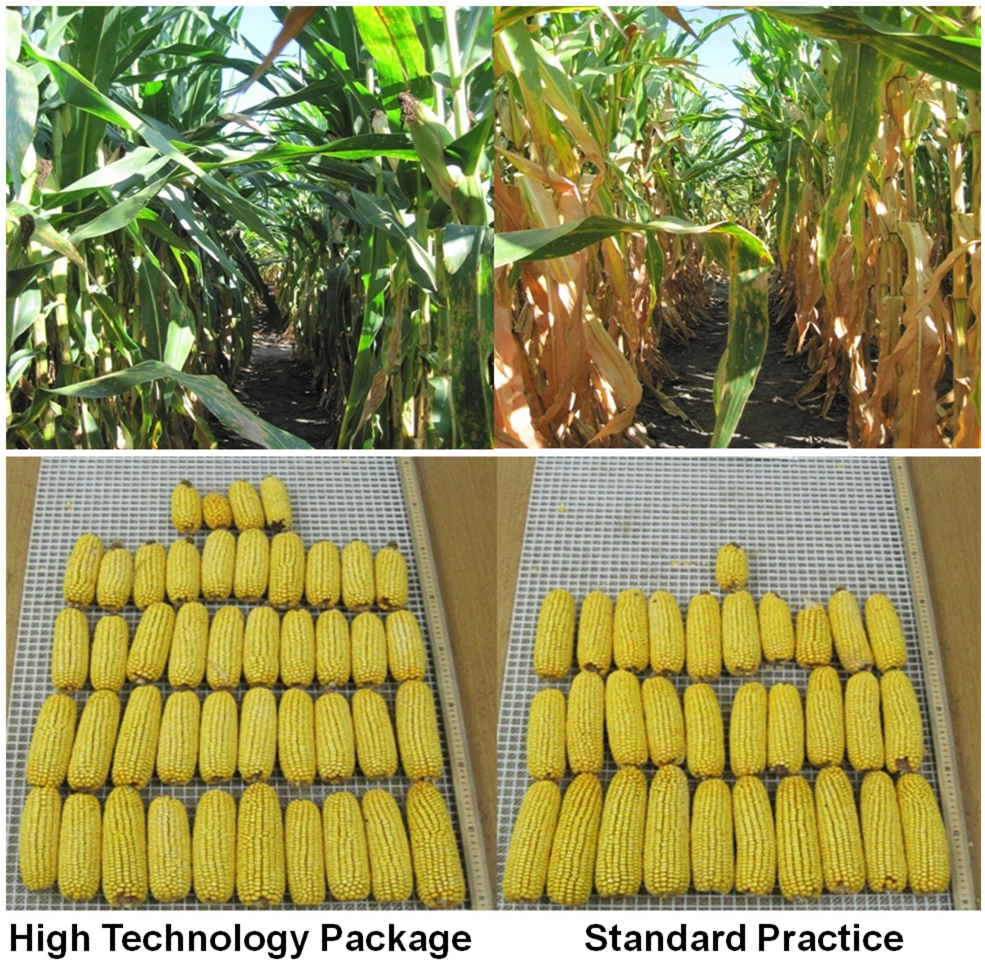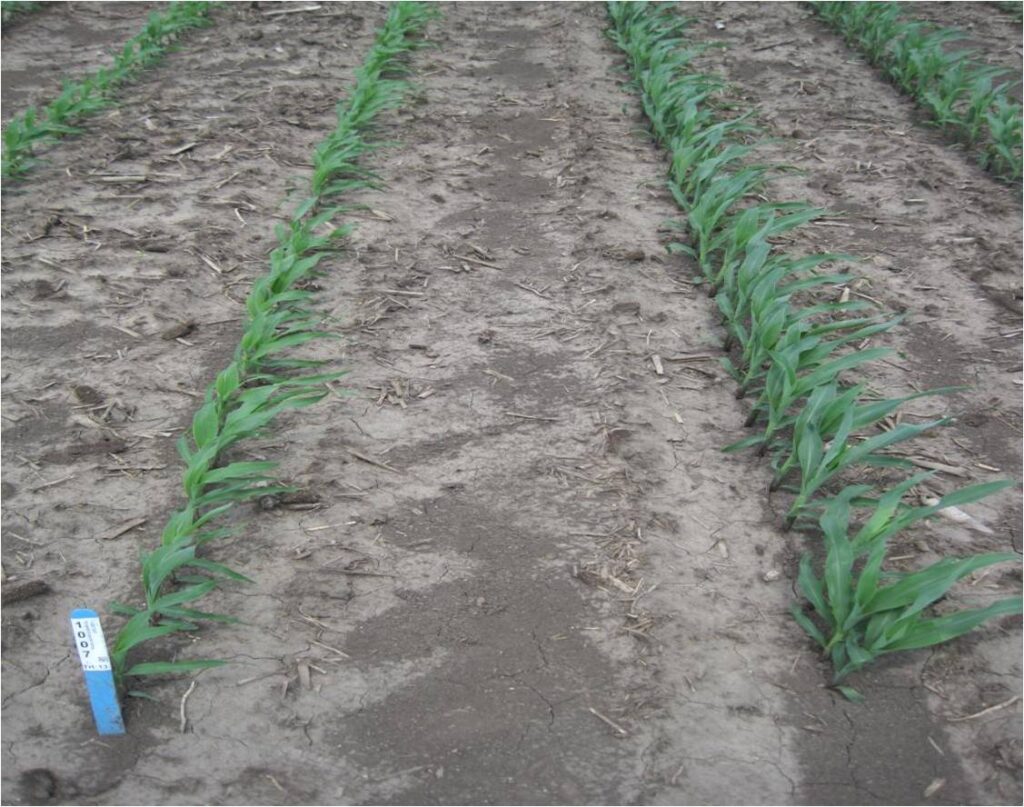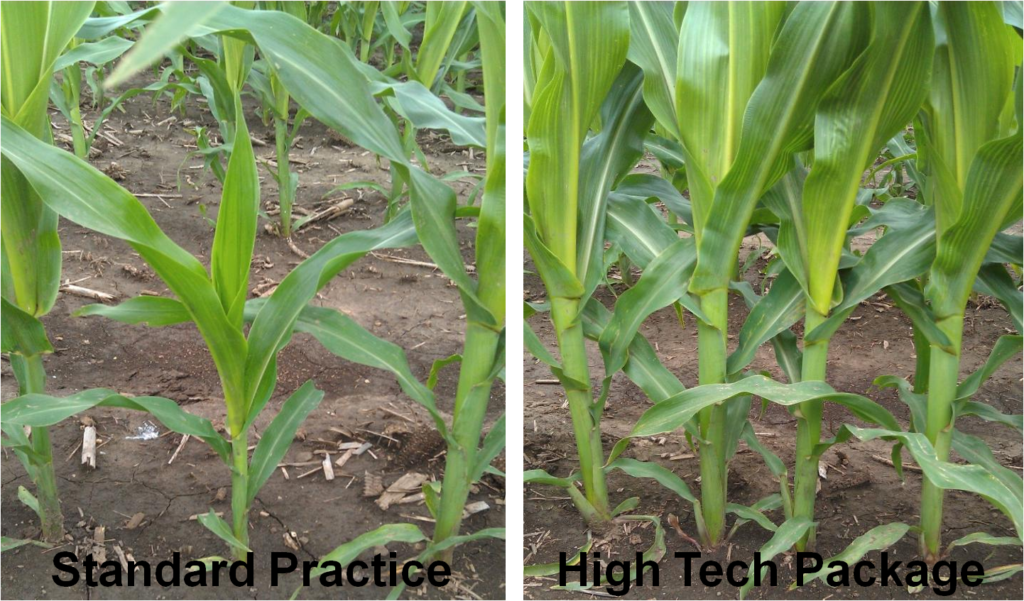Management factors that contribute to high corn yields
Quantifying their value using an omission plot approach
Executive summary
The Seven Wonders of the Corn Yield World include weather, nitrogen, hybrid, previous crop, plant population, tillage, and growth regulators. If the maximum positive yield responses of each of these individual factors are summed together, a yield of approximately 260 bushels/acre can result. Therefore, to surpass this yield level, new management approaches that either increase the potential contributions of individual factors or exploit positive synergistic interactions among multiple factors are needed.
Typically, agronomic studies tend to investigate each factor in separate experiments as an attempt to simplify the experimental design and interpretation of data. This reductionist approach has resulted in an underestimation of the value of modern genetics, crop protection products, and fertilizers that contrasts with the complexity of modern agriculture. Therefore, it is critical to understand the interactions of these factors evaluated as a whole in order to efficiently maximize corn yield and exploit the yield potential of modern corn hybrids grown under advanced levels of management. We believe that this type of research and information will be needed to develop technology packages that can take corn yields to the next level (300 bushels/acre), which is needed to meet an ever increasing food, feed, and fuel demand while sustaining the efficiency and productivity of our agricultural systems.
We have implemented a new experimental design to analyze the value of management factors that contribute to corn yield (Ruffo et al., 2010). This so-called omission plot approach allows us evaluate these management factors under traditional and high-tech approaches. In initial studies conducted in 2009 and 2010, a five-factor ‘high technology’ package was compared to a ‘standard’ package using an omission plot approach. Averaged across two sites and both years, the yield gain from the high technology package was approximately 50 bushels/acre. At the high technology level, all five factors contributed to the overall yield, and it was clear that their individual values under a high tech system were magnified in comparison to the standard system. Based on these earlier successes, the treatment levels for each factor were modified in the 2011 trials to include banded fertility (placement of P fertilizer 4-6” directly under row at planting), and to more thoroughly investigate the role of hybrid selection in the high technology package.
2009-2010 omission plot trials
Phosphorus fertility, nitrogen, genetics, population, and fungicide were the five factors evaluated in the 2009-2010 omission plot trials (Table 1). The standard package was designed to mimic a traditional farmer practice. Fertility was based on adequate soil test levels, and nitrogen was applied pre-plant as 180 lb N/A urea ammonium nitrate (UAN; 28-0-0). The hybrid that we used (DKC61-22 RR2) was a ‘refuge’ hybrid meaning that it did not possess insect resistance (glyphosate tolerance only). This hybrid was grown at a final stand of 32,000 plants/A and did not receive a strobilurin fungicide application at VT/R1.
In contrast, the five-factor high tech package included 100 lb P2O5 as Mosaic’s MicroEssentials SZ (MESZ; 12-40-0-10S-1ZN). This extra fertility was spring broadcast ahead of planting. An extra 100 lb/A of sidedress N was applied at V5/V6 in addition to a base rate of UAN (180 lb N/A). This extra sidedress N was supplied as Agrotain’s SuperU. The hybrid possessed resistance to corn rootworm as well as European corn borer (DKC61-19 VT3) and was grown at a final stand of 45,000 plants/A. The high tech plots received an application of pyraclostrobin (Headline) at VT/R1.
The trial consisted of twelve treatments in a randomized complete block design with six replications (Table 2). Treatment 1 was the high tech package, and treatment 7 was the standard practice. Our omission plot design consists of replacing the high tech level of a given factor by its standard level (treatments 2 to 6), one factor at a time, and replacing the standard level of a given factor by its high tech level (treatments 8 to 12).
This trial was planted at two Illinois locations (Champaign and Dixon Springs) in 2009 and 2010.
Averaged across both locations and years, the yield gain from the high tech package relative to the standard farmer practice was 52 bushels/acre. Representative ears from each treatment are shown in Figure 1. Due to the higher population of 45,000 plants/acre, the high tech package resulted in an increase of 13,000 ears/acre. Although individual ears tended to be smaller in the high tech package, the increase in ear count was sufficient to significantly raise yield.
There were stark differences in leaf senescence between the standard practice and high tech package (Figure 1). We attribute the improvement in leaf greening to the extra fertility (N and P), biotech insect protection (i.e., active roots), and fungicide treatments in the high tech package.
Yields were 193 and 245 bushels/acre for the standard practice and high tech package, respectively. Biotech insect protection (yield increase) and higher population (yield decrease) were the only factors that significantly impacted yield under the standard practice approach (Table 3). All factors contributed significantly to overall yield of the high tech package (Table 4).
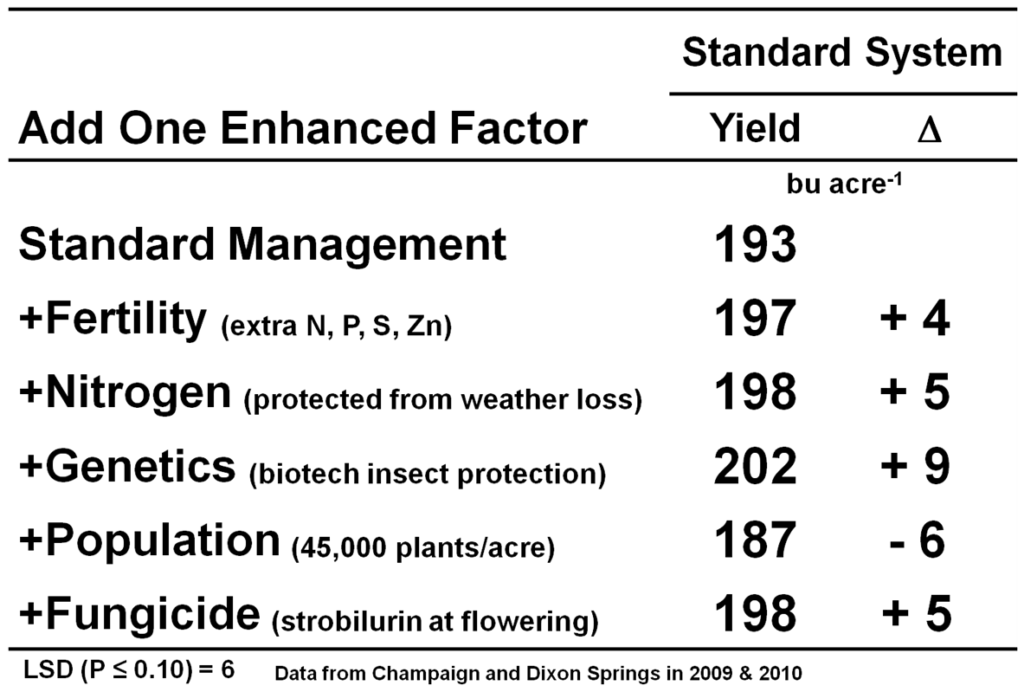
Table 3. 
Table 4
Table 4. Grain yields of high tech package and treatments which remove individual factors one at a time, and replace them with their corresponding standard level.
Conclusions from 2009-2010 trials
- There was less response to the individual management factors under the standard practice in comparison to the high tech package (Tables 3 and 4).
- The sum of the factors under the standard practice was 17 bushels/acre, yet the difference between the standard practice and the high tech package was 52 bushels/acre. This suggests that positive interactions exist among the factors when used in concert.
- All factors contributed to grain yield under high tech management (Table 4), and the magnitude of each individual factor was magnified in comparison to the standard practice addition treatments. For example, the fungicide was worth only 5 bushels/acre in the standard practice; however, there was a 27 bushel/acre decrease when fungicide was omitted from the high tech package. This represents a 5.4-fold increase in value!
- Significant gains in corn grain yield can be made by identifying packages of management factors that are worth more than the sum of their individual components.
2011 omission plot trials
Based on what we learned from the 2009-2010 omission plot trials, we refined our approach for the 2011 trials (Table 5). No changes were made to the population or fungicide factor treatments, while the fertility, nitrogen, and genetics treatments were modified:
- In 2009-2010, we broadcast the extra fertility in the spring ahead of planting. In 2011, with the availability of a fertilizer toolbar, we banded the MESZ 4-6″ directly under the row immediately before planting.
- The nitrogen regime was modified to include a reduced total rate for the high tech treatment (240 lb N/acre) compared to that used in 2009-2010 (280 lb). The nitrogen in the high tech package was divided between a 180 lb N pre-plant application (SuperU) and a 60 lb N sidedress application (urea treated with Agrotain).
- After demonstrating the value of biotech insect protection, our goal was to select hybrids for specific management systems. Hybrids were selected by our seed company collaborators to represent ‘workhorse’ and ‘racehorse’ genetics. Our presumption was that workhorse hybrids would be best suited to the low management intensity of the standard package, and that they would not be responsive to the high tech package. We also assumed that a hybrid designated as a racehorse would be responsive to increased inputs, especially increased population and nitrogen. In parallel with the omission plot trials, we characterized ‘workhorse’ and ‘racehorse’ hybrids using nitrogen and plant density treatments in our Management Yield Potential trial.
We planted twelve omission plot trials across four Illinois locations in 2011 (Table 6). The extra fertility (placed MESZ), nitrogen, and population treatments were the same for every trial. Hybrid comparisons (workhorse vs. racehorse) were varied to encompass different relative maturities and seed brands. Fungicide treatments consisted of either Headline AMP (BASF) or Quilt Xcel (Syngenta).
Planting dates for these experiments ranged from 11 May to 04 June 2011. We learned quickly that spring placement of fertilizer in research plots is a tedious and time consuming task, even with a fertilizer toolbar. The wide range of planting dates, however, allowed us to sample a variety of different planting conditions and growth environments.
We were amazed by the early-season improvement in growth that occurred as a result of the banded P fertility (Figure 2). The response occurred regardless of planting conditions, soil type, or hybrid in all 12 trials. Although the summer of 2011 would eventually turn out to be hot and dry, spring 2011 was generally characterized by periods of cool, wet weather.
The cool, wet spring promoted nitrogen loss as well as slow mineralization of many soil nutrients including nitrogen and phosphorus. In the example shown in Figure 2, an enhancement in growth and color was visually apparent soon after emergence (V3-V4). The row on the right of the photo received the placed fertility. Although the row on the left did not receive extra fertilizer, the toolbar ran through this row demonstrating that the growth enhancement is a result of fertilizer as opposed to a localized tillage effect.
The uniformity of emergence was also reduced by the cool conditions of spring 2011. Prevalent in many fields, including our research sites, were so-called ‘plants left behind’ (Figure 3; left). Plants that emerged a day or two later than their counterparts did not compete effectively and did not contribute to yield. In plots where we placed extra fertility, however, there was a substantial increase in the uniformity of early vegetative growth (Figure 3; right). This leads us to believe that plants sense their fertility resources soon after emergence.
Across trials, the average yield gain from the high technology package was 26 bushels/acre, and ranged from a 7 bushel decrease to a 56 bushel increase (Figure 4). Some of this varied response can be attributed to environment, but it is also clear from our data that correct hybrid placement is crucial to the success of the high tech package. For example, selecting high population intolerant hybrids for the high tech package led to smaller than expected responses in many cases.
Averaged across omission plot trials, placed P fertilizer had the greatest individual positive effect on grain yield in both the standard practice and high tech package (Tables 7 and 8). On average, increased population had a negative impact on yield in the standard practice, and a neutral effect on yield in the high tech package. We attribute these poor plant density responses to the generally stressful environment of 2011, but it is also clear that the impact of population was greatly influenced by hybrid selection. Yield responses to fungicide application were also generally small in 2011, but there was a statistically significant response to fungicide in the high tech package (Table 8).
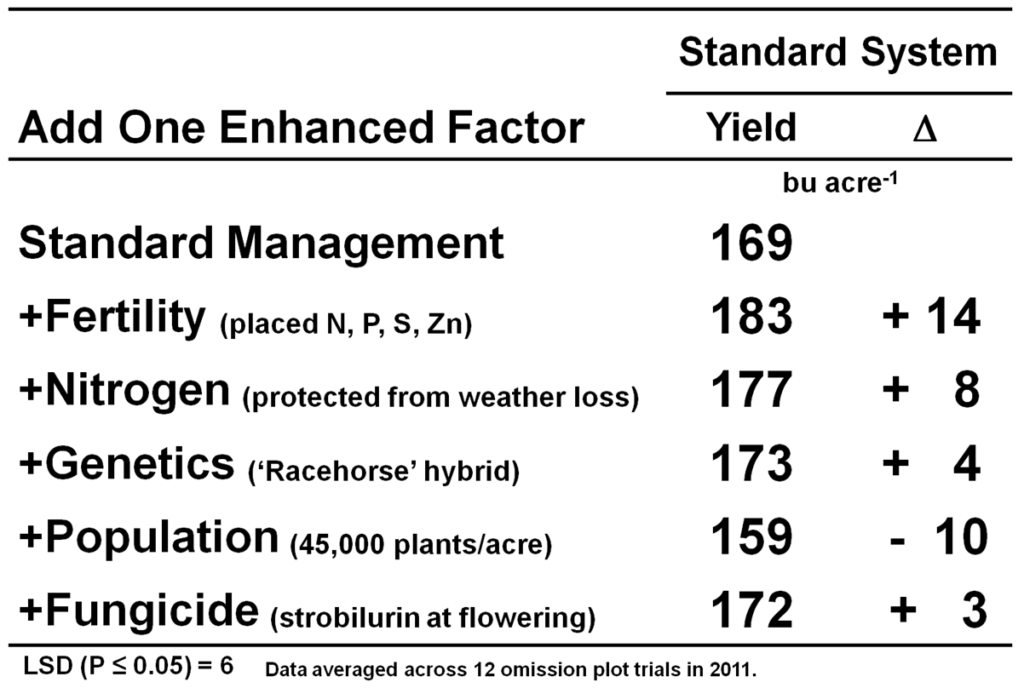
Table 7 
Table 8
Table 8. Grain yields of high tech package and treatments which remove individual factors one at a time, and replace them with their corresponding standard level.
Conclusions from the 2011 trials
- The factors which affected yield early in the 2011 growing season (extra fertility and weather protected nitrogen) were those that had the greatest impact on yield in both management systems (Tables 7 and 8).
- Placed fertility (100 lb P2O5/acre as MicroEssentials SZ) was the individual factor with the greatest value under the standard practice (14 bushels/acre) and the high tech package (17 bushels/acre). These yield increases occurred in soils that tested high for phosphorus. This result indicates that fertility recommendations may not be adequately calibrated for current genetics and production practices.
- Hybrid selection was critical for achieving success in the high tech package. Racehorse hybrids were often the best hybrids under both management systems. There was greater risk to improperly positioning a ‘workhorse’ hybrid in the high tech system due to intolerance of increased plant density.
- Although we did not experience measurable disease pressure in 2011, application of a strobilurin fungicide was still beneficial in the high tech package (Table 8).
Related documents and links
- Below, F.E., A.S. Henninger, and J.W. Haegele. 2011. A report of crop physiology laboratory omission plot studies in 2011. [PDF, 270 KB]
- Henninger, A.S. 2012. Analysis of management factor contributions to high-yielding corn production systems. University of Illinois at Urbana-Champaign MS thesis. [link to abstract and PDF]
- Ruffo, M., A. Henninger, and F. Below. 2010. A new experimental design to analyze the value of management factors contributing to high corn yield. Poster presented at the Crop Science Society of America International Annual Meeting. October 31 – November 4, 2010. Long Beach, CA. [external link to meeting abstract] [PDF, 117 KB]
